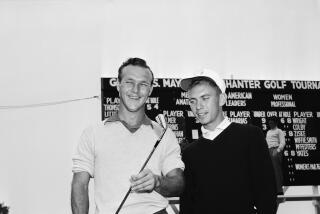Kings OF Swing : Bunyanesque Drives Go Over Big With Fans, Charities Big Wave Dave Menary
A thick fog cloaked the golf course like a wet tissue, heavy and clinging and dense enough that only vague outlines were visible in the early-morning light. Suddenly, the damp silence was snapped by a loud crack, an electrifying, jolting sound . A small group of golfers, gulping rolls and muffins and buckets of dark coffee while huddled near the clubhouse, abruptly stopped what they were doing and stared into the white mist.
CRACK.
Several of the golfers put down their food and coffee cups and began slowly moving into the heavy haze, heading toward the sound like lemmings to the sea.
CRACK.
As they drew closer, the sound grew, not only in volume but in intricacy. Now, along with the loud crack , every 15 or 20 seconds came other noises. Great big whooshing sounds that preceded each crack by milliseconds. And a subtle but distinct grunting noise that seemed to come almost simultaneously with the loud crack .
Whichever creature was making these noises deep in the shroud of fog was, by all logical assessments, a mammal.
It was Frank Miller.
He was hitting golf balls.
Well, technically he was hitting golf balls. He did have a golf club. And he was swinging it. And the club was striking golf balls. But to say that Miller was hitting golf balls would be to say that the Titanic nudged something one night.
No, Miller was doing much more than just hitting golf balls. He was crushing them. He was punishing them, it seemed, for all of the sins of mankind. He was conducting an experiment into just how violently a human being can swing a club against an object, a swing that had some grace to it but was overwhelming in its ferocity.
How hard was Miller hitting the ball? Hard enough to crack both the solid graphite face and the steel sole plate on his $300 driver.
At 6-foot-6 and 250 rock-hard pounds, Miller, 30, of Los Angeles, did not even look like a golfer. Craig Stadler looks like a golfer. Miller looked like a pro wrestler. Or one of those overly pumped American Gladiators on that thought-provoking TV show. Or a former tight end for the University of Oregon, which he is.
As a gathering crowd nudged closer and the fog swirled about the North Ranch Country Club in Thousand Oaks, Miller pounded golf balls into infinity--infinity being about 50 yards in those London-like conditions. But you had a strong notion that the golf balls he was launching were traveling more than 50 yards. And more than 100 and more than 200. And more than 300.
And a while later, after other long-driving legends had joined Miller on the practice tee and six giants began launching rockets into the fog, you had a hunch things were getting a bit out of control when North Ranch course manager Jim Bammer came running through the mist, eyes wide, shrieking at the men to cease their assault.
“Stop! Stop!” Bammer barked. “You’re hitting into our maintenance sheds. We’ve already got two guys down.”
Two guys down? In golf?
The guys down were indeed whomped by the missiles sent into the blanket of fog. One took a direct hit from a Nitro-brand ball in the back and yelped wildly. The other took a solid hit high on the leg. He too yelped. The rest of the course maintenance workers then dived into the sheds and behind tractors to wait out this blind assault.
The maintenance and equipment area was 340 yards from the practice tee. Behind a 50-foot-high protective net.
Net, schmet.
The giants were just warming up.
Comparison: John Daly, the 1991 PGA Championship winner who has used up millions of gallons of newspaper ink with his “awe-inspiring, stunningly long drives,” averages 289 yards off the tee. Miller and others who gathered earlier this week for the Legends of Long Drive contest hit balls 290 yards with their irons .
Joining Miller on the range was a Who’s Who of gorilla golfers. There was Big Wave Dave Menary of Marin County, a four-time national long-drive champion with a big body and a bigger swing. A wave , by the way, is a golfer’s term for a ball that goes so far out of bounds that search-and-rescue dogs couldn’t find it. Hence, Menary’s nickname.
There was Mike Dunaway of Arkansas, author of a long-drive book and producer of numerous videotapes on how to hit the ball into next week. There were Mike Gorton of Santa Barbara, the 1987 national long-drive champion, and Gary (Hambone) Hambright, 35, of Orange, who weighs 275 pounds and hits a golf ball 375 yards on a regular basis.
They came together on the practice tee with Miller, 30, who won a long-drive tournament last year in Miami with a launch of 417 yards. There was, Miller concedes, a slight, 10 m.p.h. tail wind on that flight.
And finally, there was the longest of them all, Cary Schuman of Agoura, the man the other long drivers call Smoke. Schuman, 39, stamped his name into the Guinness Book of World Records in 1990 with a sea-level (Hawaii), no-wind, flat-hole blast of 411 yards in a PGA-sanctioned tournament. And last year, competing in a long-drive tournament in Chicago on a calm day, he astounded everyone with a drive that shrieked through the air for a stunning 400 yards and then ripped up the fairway for an additional 63 yards. That 463-yard shot is a pending Guinness entry.
Together on the same practice tee, these six massive-swinging golfers held a gallery of 200 spellbound for two hours before the contest. Golf balls took the beating of their lives and more than $50,000 was raised for Los Angeles-based Permanent Charities.
Also raised was the hair on the backs of spectators’ necks. The power golfers generate clubhead speed and, subsequently, a force at impact that boggles the mind. Hambright, for example, had a clubhead clocking of 150 m.p.h. earlier this year in a tournament laden with radar guns. The average weekend golfer generates a clubhead speed of about 75 m.p.h.; touring PGA pros register average clockings of about 95 m.p.h.
Of course, PGA stars place great significance on being able to find the ball after they hit it.
The long-drivers usually get six chances in a tournament to put the ball on the fairway. Once they do that, generally with a first or second swing, they grease the hinges.
Menary hesitated before he hit his first ball in the North Ranch event. He bent over to tie his shoes. But he didn’t call it tying his shoes.
“Got to tighten the lug nuts,” was the way he put it.
And if ever a man is actually going to swing out of his shoes , as the old golf saying goes, it likely will be Menary. Winding up with a backswing and hip turn that leaves him facing 180 degrees from the ball, he then snaps everything back to the left--hips, shoulders, arms, hands and various other body parts--so quickly that it is just a blur. One particularly nasty swing on the practice range brought Menary’s feet free of the ground, his 245-pound body spinning in the air after impact.
Not a swing you can--or should, under any circumstances--teach.
In the contest, Big Wave Dave couldn’t quite reel it in. After one mammoth blast soared far, far right, he quickly noticed dwellings in that direction and barked out “Condos!” as the ball headed for a two-story, tile-roofed building.
Another drive that went even farther right brought this reaction from the frustrated Menary: “My, my. Wasn’t that special?”
He did drop one bomb into the fairway. It measured 321 yards 7 inches.
Child’s play.
Schuman crashed a drive that slammed the soggy fairway at 345 yards and backed up two feet. Giant Frank Miller went to the lead with the fourth of his six drives, a beast that eventually stopped rolling at 350 yards 2 feet.
Huge Gary Hambright cranked one past that, a drive that startled the closest onlookers with the sound as it left the club, a drive that settled onto the grass 352 yards 1 foot 3 inches from the tee.
And then the 6-3, 225-pound Gorton slammed one four inches past Hambright’s monster. The winning launch of 352 yards 19 inches earned Gorton a check for $3,500.
Hambright earned $1,500 for second place, and at the awards dinner later that night gave $500 of it back to the Permanent Charities. Gorton then gave $504 of his winnings to the charity and, standing in front of the large gathering, announced to Hambright, “Got you by four again,” a crack that brought the house down.
It likely was not the only house Gorton has brought down around a golf course. The others, however, usually have roofs and windows.
“When you play golf like we do,” Gorton said, “you see a lot of people standing nearby with really big eyes.”
More to Read
Go beyond the scoreboard
Get the latest on L.A.'s teams in the daily Sports Report newsletter.
You may occasionally receive promotional content from the Los Angeles Times.










